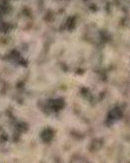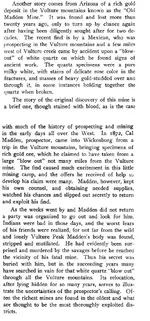Oroblanco
Gold Member
- Joined
- Jan 21, 2005
- Messages
- 7,841
- Reaction score
- 9,876
- Golden Thread
- 0
- Location
- DAKOTA TERRITORY
- Detector(s) used
- Tesoro Lobo Supertraq, (95%) Garrett Scorpion (5%)
- #1
Thread Owner
Most treasure hunters are familiar with the famous Lost Dutchman gold mine of Jacob Waltz, supposed to be in the Superstition Mountains. Not so many are familiar with the OTHER Lost Dutchman gold mine of Arizona, which predates Waltz and was somewhere around Wickenburg.
One variety of the "Lost Dutchman" story concerns the operations of a German who made his headquarters at Wickenburg, in the early seventies. He had a very irritating habit of disappearing from the camp once in a while, going by night, and taking with him several burros, whose feet would be so well wrapped that trailing was impossible. He would return at night, in equally as mysterious a manner, his burros loaded with gold ore of wonderful richness. Efforts at tracking him failed. The country for miles around was searched carefully to find the source of his wealth, which could not have been very far distant. The ore was not the same as that at Vulture. The location of the mine never became known to anyone, save its discoverer. He disappeared as usual one night, and never returned. The assumption that he was murdered by Apaches appears to have been sustained by a prospector's discovery near Vulture in the summer of 1895 of the barrel of an old muzzle-loading shotgun, and by it, a home-made mosquito gun stock. The gun had been there so long that even the hammer and trigger had rusted away. Near by was a human skeleton, bleached from long exposure. The next find was some small heaps of very rich gold rock, probably where sacks had decayed from around the ore, and then at a short distance was discovered a shallow prospect hole, sunk on a gold-bearing ledge. The ore in the heaps was about the same character as that which had been brought into Wickenburg in the early days by the "Lost Dutchman," but it didn't agree at all with the ore in the shallow prospect hole, which was not considered worthy of further development.
<from Arizona, Prehistoric, Aboriginal, Pioneer, Modern: The Nation's Youngest
by James H. McClintock - Arizona - 1916 pp 392, online at Google books>
That this can not be Jacob Waltz is obvious from the fact his body was found several years after Waltz had passed away. The Vulture mine is one of the richest gold ore bodies in Arizona, but this other Dutchman must not have been simply highgrading from the Vulture as the ore was noticeably different. Highgrading was a major problem at the Vulture mine, discovered in 1863 by Henry Wickenburg but sold a few years later. Men caught highgrading (stealing high grade ore) were often hanged, supposedly at least 18 men were hanged at the Vulture over the years.
The region around Wickenburg is well known for being mineralized, and the presence of the Vulture mine shows just how rich it might be (the Vulture is believed to have produced at least $200,000,000 in gold before shutting down in 1942) so there is every reason to believe that this Lost Dutchman mine was not too far from Wickenburg.
I would appreciate any details that anyone can add to the story, whether documented or not. Thank you in advance.
Oroblanco
One variety of the "Lost Dutchman" story concerns the operations of a German who made his headquarters at Wickenburg, in the early seventies. He had a very irritating habit of disappearing from the camp once in a while, going by night, and taking with him several burros, whose feet would be so well wrapped that trailing was impossible. He would return at night, in equally as mysterious a manner, his burros loaded with gold ore of wonderful richness. Efforts at tracking him failed. The country for miles around was searched carefully to find the source of his wealth, which could not have been very far distant. The ore was not the same as that at Vulture. The location of the mine never became known to anyone, save its discoverer. He disappeared as usual one night, and never returned. The assumption that he was murdered by Apaches appears to have been sustained by a prospector's discovery near Vulture in the summer of 1895 of the barrel of an old muzzle-loading shotgun, and by it, a home-made mosquito gun stock. The gun had been there so long that even the hammer and trigger had rusted away. Near by was a human skeleton, bleached from long exposure. The next find was some small heaps of very rich gold rock, probably where sacks had decayed from around the ore, and then at a short distance was discovered a shallow prospect hole, sunk on a gold-bearing ledge. The ore in the heaps was about the same character as that which had been brought into Wickenburg in the early days by the "Lost Dutchman," but it didn't agree at all with the ore in the shallow prospect hole, which was not considered worthy of further development.
<from Arizona, Prehistoric, Aboriginal, Pioneer, Modern: The Nation's Youngest
by James H. McClintock - Arizona - 1916 pp 392, online at Google books>
That this can not be Jacob Waltz is obvious from the fact his body was found several years after Waltz had passed away. The Vulture mine is one of the richest gold ore bodies in Arizona, but this other Dutchman must not have been simply highgrading from the Vulture as the ore was noticeably different. Highgrading was a major problem at the Vulture mine, discovered in 1863 by Henry Wickenburg but sold a few years later. Men caught highgrading (stealing high grade ore) were often hanged, supposedly at least 18 men were hanged at the Vulture over the years.
The region around Wickenburg is well known for being mineralized, and the presence of the Vulture mine shows just how rich it might be (the Vulture is believed to have produced at least $200,000,000 in gold before shutting down in 1942) so there is every reason to believe that this Lost Dutchman mine was not too far from Wickenburg.
I would appreciate any details that anyone can add to the story, whether documented or not. Thank you in advance.
Oroblanco





 heh heh yep that sure sounds like the right guy!
heh heh yep that sure sounds like the right guy! 





 NO gracias compadre!
NO gracias compadre!

